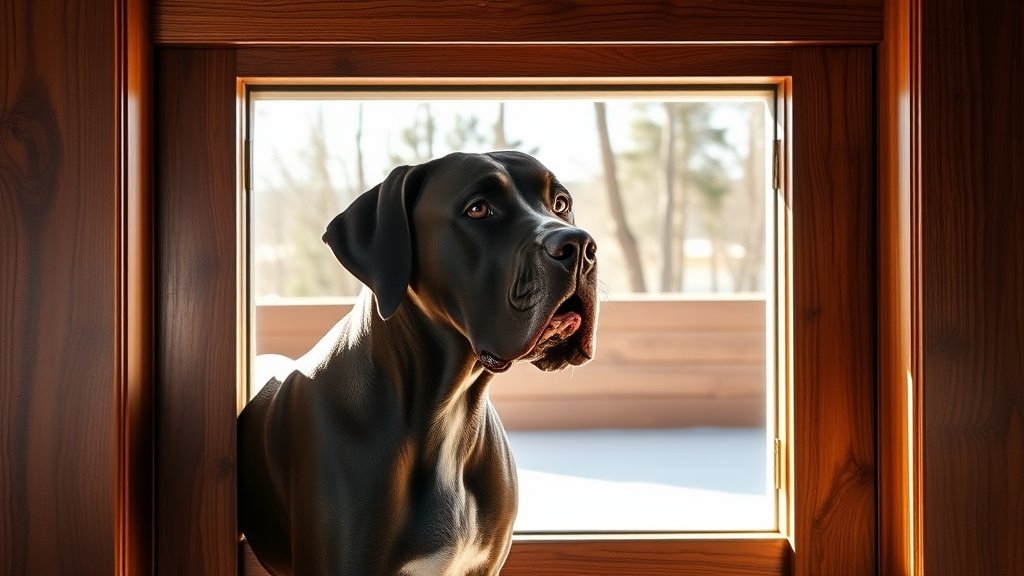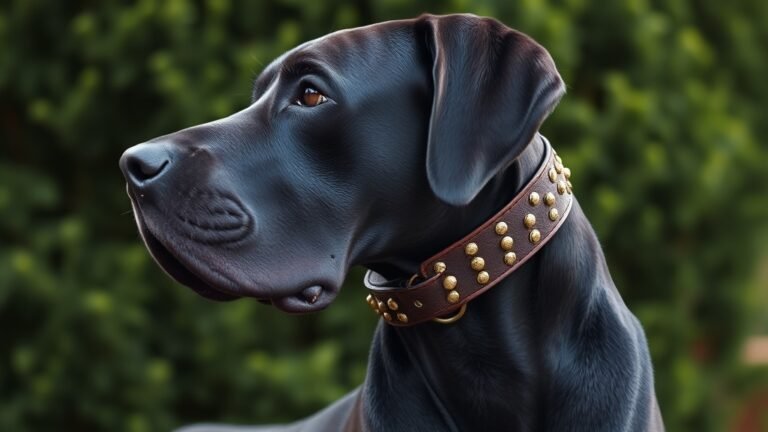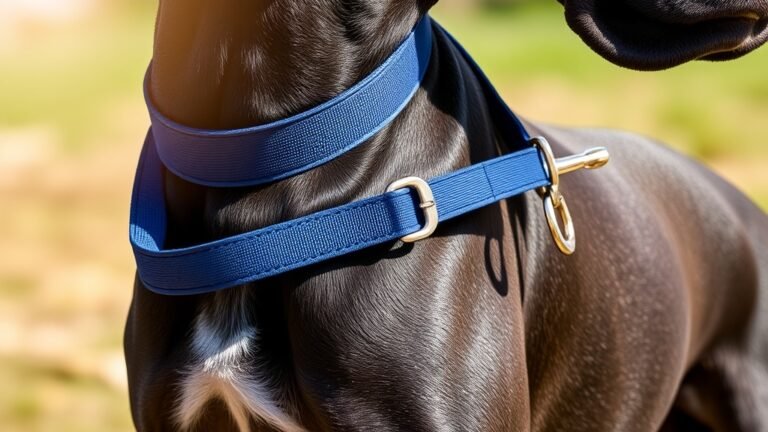Best Dog Door for a Great Dane
Best Dog Door for Great Dane
Woof! Listen up, fellow humans – it’s me, your friendly neighborhood Great Dane, and I need to talk to you about something super important: dog doors that fit my massive self!
Trust me, I’ve tried squeezing through those tiny doors meant for my smaller cousins, and let’s say it didn’t end well. Picture a furry bulldozer trying to fit through a keyhole – not pretty! That’s why you need to think BIG when shopping for my door.
Here’s what this gentle giant needs: a door that’s at least 32 inches tall and 24 inches wide. I’m not asking for much, just enough space so I don’t have to army-crawl through like I’m in some weird obstacle course. My dignity can only take so much!
The door also needs to be tough enough to handle my enthusiasm. When I see a squirrel in the yard, I don’t exactly tiptoe through doors – I charge! So make sure that frame is sturdy, because nobody wants a Great Dane-shaped hole in their wall.
Weather protection is huge, too. My beautiful coat might look impressive, but I don’t enjoy getting soaked by rain sneaking through cheap flaps. The Ideal Pet Products Extra Large Dog Door and the Endura Flap Dog Door are two great options that keep the weather where it belongs – outside!
Trust me, invest in the right door, and we’ll both be much happier. No more embarrassing door-diving incidents for me, and no more replacing broken doors for you!
Ideal Sizing for Great Dane Dog Doors
You humans need to think BIG when you’re shopping for my door. I’m not your average pup, so that tiny door you bought for your neighbor’s Chihuahua? Yeah, that’s not going to work. I’d get stuck faster than a tennis ball under the couch!
Here’s what I need: a door that’s at least 32 inches tall and 24 inches wide. Trust me, I’ve measured myself (okay, my human did, but I supervised). My shoulders are pretty broad – I work out, you know – and I need room to wiggle through without doing some weird limbo dance every time I want to go outside.
The bottom of the door should be about 10 inches off the ground. This is super important because I don’t want to have to army crawl like I’m sneaking past the cat. My knees aren’t getting any younger!
When you get the sizing right, I can cruise in and out like the majestic giant I am. No more getting stuck halfway through or having to squeeze like I’m trying to fit into last year’s collar. An appropriately sized door means I can chase squirrels, come back for snacks, and repeat – which is basically my life plan. Additionally, keeping me safe from heartworm disease is crucial, so make sure I’m protected when I’m out exploring!
Construction and Durability Features
When us Great Danes need a dog door, we want something that won’t fall apart when we come barreling through! Trust me, I’m a big dog with lots of enthusiasm, and regular doors just don’t cut it.
My humans need to look for a door with a super strong frame that won’t bend when I get excited about squirrels in the backyard. The flap part should be tough enough to handle all kinds of weather – because let’s be honest, I’m going in and out whether it’s sunny, rainy, or snowing. I don’t have time to wait around!
The whole thing needs to be built like it can survive a Great Dane stampede (which happens more often than my humans would like). Additionally, properly sized dog doors prevent hazards and equipment damage, ensuring a safe experience for both me and my family.
When the doorbell rings or the mailman shows up, I’m not exactly gentle when I rush outside to investigate. A flimsy door would be toast!
Getting a sturdy dog door means my family won’t have to keep fixing or replacing it. Plus, I won’t get stuck halfway through because it broke – and believe me, that’s embarrassing for a dignified dog like me.
A good door keeps everyone happy and allows me to move freely between my indoor napping spots and my outdoor patrol duties.
Reinforced Frame Design
My Frame Needs To Be Tough (Just Like Me!)
You see, when I get excited about going outside (which happens about 47 times a day), I don’t exactly tiptoe through my door. Nope! I charge through like I’m breaking down the gates of a medieval castle. My 150-pound body hits that frame with the force of a furry bulldozer.
That’s why you need to pick a door made from really strong stuff. None of that flimsy plastic nonsense that’ll crack the first time I decide to chase a squirrel at full speed. I’m talking about heavy-duty materials that can handle my enthusiasm without falling apart.
The frame needs extra support, too, because I’ve seen what happens when it doesn’t. Let’s say my neighbor’s door now looks like a pretzel, and their Golden Retriever gives me dirty looks every time I walk by. Whoops!
Trust me, investing in a super-strong frame means I can zoom in and out whenever I want without turning your beautiful door into modern art. Plus, a sturdy door also helps keep your home clean by preventing loose hair removal from becoming a daily chore!
And that makes both of us happy – me because I get my freedom, and you because you don’t have to explain to visitors why your dog door looks like it survived a tornado!
Weather-Resistant Flap Materials
Woof! Let me tell you about weather-resistant flap materials – because trust me, us Great Danes know a thing or two about doors!
You humans might love hanging out in the yard, but we need dog doors that won’t fall apart when Mother Nature throws a tantrum. When picking flap materials, think tough! You want stuff like vinyl or heavy-duty plastic that can handle rain, snow, and those sneaky UV rays that try to crack everything.
These materials are pretty smart – they keep the heat in during winter (which is great because my giant paws get cold!) and stay bendy even when it’s freezing outside. Nobody wants a flap that turns into a frozen pizza slice, am I right?
Here’s a pro tip from this 150-pound expert: get flaps with magnetic closures! They’re like magic – they snap shut behind me and keep out drafts and water. No more cold air sneaking in while I’m deciding whether I actually want to go outside or just want to check if that squirrel is still taunting me.
Plus, look for heavy-duty weatherstripping to enhance insulation and prevent drafts around the door frame.
Pick the right flap material, and we Great Danes can zoom in and out whenever we want (which is approximately every five minutes). Your house stays cozy, and we stay happy. It’s a win-win!
Spend the extra kibble money on good materials – your door will last longer than my attention span during training!
Impact-Resistant Construction
Since we Great Danes can pack quite a punch, it’s super important to pick a dog door that won’t fall apart when we come barreling through!
Trust me, you don’t want to explain to your humans why there’s a Great Dane-shaped hole in your wall (again).
Here’s what to look for when you’re helping your humans shop:
- Tough materials: Ensure it’s made from exceptionally durable plastic or aluminum. We’re not exactly delicate flowers, if you know what I mean!
- Crash test ratings: Check if the door has been tested by dogs like us who might get a little too excited about dinnertime.
- Super strong frame: The frame needs to be rock-solid so it won’t bend when we zoom through at full speed.
- Weather-tight seals: Good seals keep the door working fantastic, whether it’s hot, cold, or raining cats and dogs (hopefully just regular rain).
Getting a tough dog door is like buying a good pair of running shoes – it’s worth spending extra because we’re going to use it A LOT.
Plus, your humans will thank you when they don’t have to replace it every few months! Remember, ensuring a comfortable living space for multiple Great Danes also means selecting durable features in your dog door.
Installation Considerations for Dog Doors
When my humans think about installing a dog door for me, they need to figure out a few things. Trust me, as a Great Dane, I’ve some pretty strong opinions about this whole process!
First, my humans need to pick the perfect spot for my new door. It has to be somewhere I can fit through without getting stuck halfway. The door needs to be low enough that I don’t have to do gymnastics to get through it, but not so low that I’ve to army crawl like I’m sneaking into the kitchen for midnight snacks.
Next, my humans will need to grab their tools. They’ll need a saw, a level, and a measuring tape. I tried to help with the measuring tape once, but apparently, my nose prints all over it weren’t helpful. Who knew?
The most important part is measuring everything twice. My humans learned this the hard way when they almost cut a hole that would’ve been perfect for a Chihuahua, not a gentle giant like me. Great Danes require 30-60 minutes of daily exercise, so having a dog door could make it easier for me to get that exercise!
Following the instructions is super important too, even though my dad likes to think he knows better than the manual.
When everything is installed correctly, I’ll be the happiest dog on the block! I’ll finally have the freedom to chase squirrels in the backyard whenever I want, without having to give my humans those sad puppy dog eyes every time I need to go outside.
Energy Efficiency and Weather Resistance
Woof! Let me tell you about picking the perfect door for a magnificent dog like me. When my humans are shopping for my special entrance, they better think about keeping our house cozy and dry. Trust me, nobody wants a drafty house when you’re as big as I am – I take up half the living room already!
My humans need to look for doors with good insulation and tight seals. Why? Because when I’m 150 pounds of pure Great Dane awesomeness, I use my door A LOT. I’m in, I’m out, I’m chasing squirrels, I’m back for snacks. If that door doesn’t seal properly, all the warm air escapes faster than I can run after the mailman.
The best doors have multiple layers and effective weatherstripping. Some even have magnetic seals – pretty fancy for us dogs! This means when I’m inside taking my seventh nap of the day, the house stays warm and cozy. Also, a well-insulated door helps maintain the gentle nature of my breed by ensuring we remain comfortable in extreme weather conditions.
And when it’s raining cats and dogs (hopefully just an expression), no water sneaks in around the edges. My humans will thank me later when their heating bill doesn’t make them cry.
Plus, I get to come and go as I please without making them get up from the couch every five minutes. It’s a win-win situation for everyone in our pack!
Insulation Features Comparison
Here’s what us big dogs need to look for in a door that works:
- Insulation ratings: Think of this like a report card for keeping the cold out. The higher the grade, the warmer my paws stay! Nobody wants to hear their human complain about the heating bill because I let all the warm air escape.
- Dual-flap systems: Two flaps are better than one – it’s like wearing a winter coat AND a sweater. These double doors create an extra barrier so the chilly air can’t sneak in behind my magnificent tail.
- Weather seals: These are like invisible force fields around the edges of my door. They stop sneaky drafts from creeping in and making my human shiver while they’re trying to nap on the couch.
- Material quality: Cheap stuff breaks when a 150-pound Great Dane comes barreling through at full speed (trust me, I’ve tested this). Good materials mean my door will last longer than my favorite chew toy.
- Proper nutrition is essential to keep my energy up during all those outdoor adventures, so a well-insulated door helps keep my energy bills low while I enjoy the comfort of my home.
Sealing Quality Importance
Why Sealing Quality Matters (From Your Friendly Neighborhood Great Dane)
Woof! Let me tell you about something super important – sealing quality in dog doors. As a Great Dane, I know a thing or two about doors, mainly because I’m approximately the size of a small pony and need a REALLY good door to fit through!
Here’s the deal: good sealing quality means your dog door closes properly after we furry friends zoom through it. Trust me, us dogs don’t always have the best door manners. I’ve been known to barrel through at full speed when I hear the mailman approaching!
Why should you humans care about this? Well, nobody wants their house to turn into an icebox in winter or a sauna in summer just because Rover’s door won’t seal shut. A properly sealed dog door keeps all that expensive air conditioning and heating from escaping. Your wallet will thank you later!
Good seals also keep out rain, snow, and those annoying little bugs that nobody invited to the party. I learned this the hard way when my old door had terrible sealing. Every time it rained, I’d track in enough water to fill a kiddie pool. My humans weren’t amused.
Look for dog doors with thick, flexible seals that snap back into place quickly. The best ones work like magic – they let dogs through easily but close up tight behind us. It’s like having a bouncer for your house, but one that likes dogs!
Energy Efficiency Benefits
Energy Efficiency Benefits
An awesome dog door that seals tightly is like having my own personal entrance that doesn’t let all the good air escape. Here’s why my humans get so excited about it (and why I should care):
- No more crazy drafts that make my ears flap around when I’m trying to nap
- Keeps the house from turning into an icebox in winter or an oven in summer
- My humans smile more when they look at the electric bill (which means more treats for me!)
- I can zoom in and out whenever I want without making them get up from the couch
The best part? My humans aren’t constantly complaining about heating and cooling costs anymore. Instead, they’re talking about how smart their giant dog is for using his special door.
I get to stay comfortable, they save money, and everyone’s happy.
It’s basically like having a magic portal that keeps the good stuff in and the bad weather out. Plus, I look pretty cool using it – like a furry superhero with my secret entrance!
Measurement Techniques for Accurate Sizing
Woof! Let me tell you how my humans can get the perfect door size for a magnificent dog like me. First, they need to grab a tape measure or ruler – and trust me, they’ll need the BIG tape measure because I’m not precisely a Chihuahua!
My humans should measure my height, width, and length while I’m standing up straight and looking regal (which is pretty much all the time). They need to check how tall I am at my shoulders and how wide I am around my belly – especially after I’ve had my dinner! Pro tip: Don’t let them measure me when I’m doing my morning stretches because that’s just showing off.
Once they’ve all my impressive measurements, they can consult the sizing charts created by door companies. These charts are like cheat sheets that tell humans what size door a dog of my enormous greatness needs.
The best part? When they get the right size, I can zoom in and out of the house whenever I want! No more waiting for my slow humans to open doors for me. I can chase squirrels, come back for snacks, and go back out to patrol the yard like the noble guardian I am.
Getting the measurements right means I won’t get stuck halfway through the door, which would be embarrassing for a sophisticated dog like me!
Top Recommended Products for Great Danes
When it comes to picking the best dog door for us Great Danes, I’ve got some pawsome recommendations! Trust me, I know what we big pups need. We’re not exactly pocket-sized, so we need doors that can handle our magnificent size and boundless energy.
Here are my top picks for fellow Great Danes:
- Ideal Pet Products Extra Large Dog Door: This one’s tougher than my favorite chew toy and way easier to install than teaching a human to fetch.
- PetSafe Staywell Large Dog Door: Weather-resistant like my coat after a good shake! Perfect whether it’s raining cats and dogs (but hopefully just rain).
- PlexiDor Performance Dog Door: Built heavy-duty for us active pups who might get a little too excited about squirrels in the yard.
- Endura Flap Dog Door: Energy-efficient and made for us larger-than-life breeds who need room to squeeze through.
These amazing pet accessories will give us Great Danes the freedom we deserve! No more waiting by the door doing our “I need to go outside” dance while our humans finish their coffee.
We can finally come and go as we please – which is precisely how it should be!
Final Thoughts
In summary, picking the right dog door for me isn’t just about making sure my giant paws fit through – though trust me, that’s pretty important! It’s about finding something strong enough to handle my enthusiasm when I spot a squirrel, easy enough for my humans to put up without too much head-scratching, and something that won’t make the house freezing cold in winter. We’ve looked at all the cool features and best choices, but here’s what I’m wondering: which door can survive my daily zoomies and still work perfectly? While my humans think about it, I want to make sure they pick a door that fits my massive self and makes our home even better. After all, a happy Great Dane means happy humans – and I promise I’ll try not to knock anyone over when I come charging through my new door!
References
- https://plexidors.com/questions/is-there-a-plexidor-that-will-fit-my-great-dane/
- https://www.petdoorstore.com/blog/wall-and-door-pet-doors-for-great-danes-and-other-giant-breeds
- https://enduraflap.com/pages/measure-your-pet
- https://www.wayfair.com/sca/ideas-and-advice/guides/your-guide-to-dog-door-sizes-T21435
- https://moorepet.com/doors/large-breed-dog-doors/







3 Comments